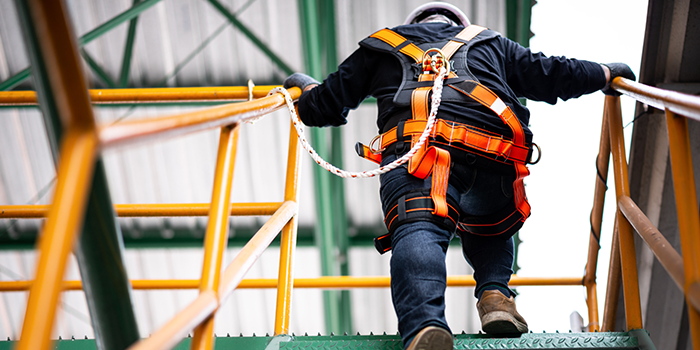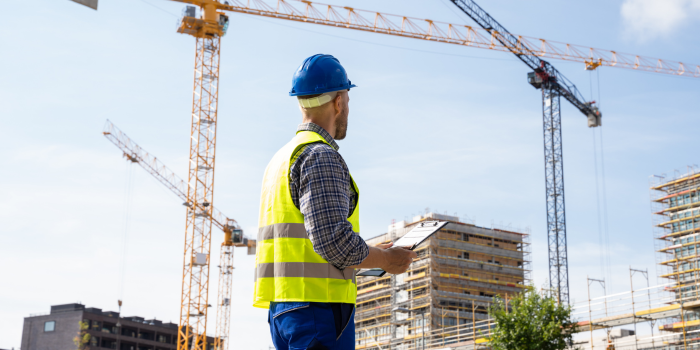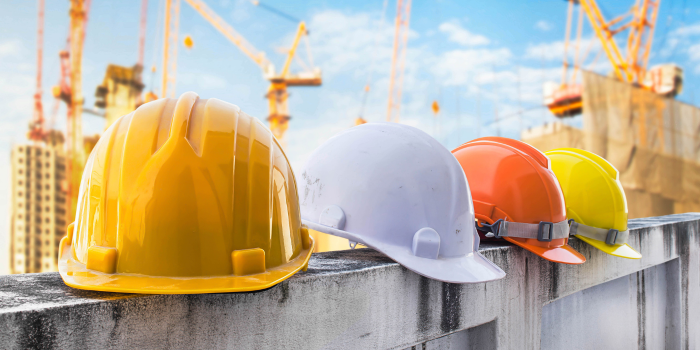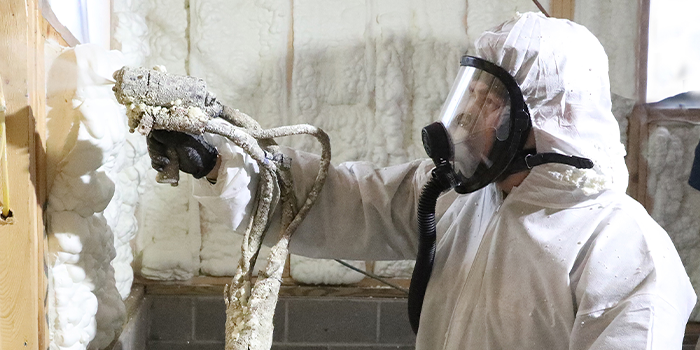Outfitting Workers with Wearable Technology


Summer 2020 – Spray Foam Magazine – The wearable tech industry was worth $23 billion in 2018 and is projected to be worth $54 billion by 2023. Many of us are wearing the latest smartwatch or Fitbit, but how might this smart wearable technology help keep construction workers safe? Spray Foam Magazine investigated how wearable tech may help prevent hazardous situations on construction sites by using technology which can alert workers of potential risks with devices like wearable sensors.
Proximity detection and warning systems utilized as wearable technology have the potential to warn workers on the ground or operating equipment when hazards such as moving heavy construction equipment are nearby. Physiological status monitors can also collect worker data in the outdoor environment and warn about the potential risk for heat stress. Environmental sensors are being used to monitor air quality, including carbon monoxide, hydrogen sulfide, gas leaks, temperature, humidity, and noise. From monitoring apps to caps which check for levels of fatigue, we have picked our favorite tech wearables on the market today.
NIOSH Are Innovators in Wearable Tech & Research
NIOSH (National Institute for Occupational Safety and Health) have been researching wearable tech since 2008, creating DREAM (Direct Reading Exposure Assessment Methods), which reports on developments in technology and lessons learned. The NIOSH have developed methods of exploring innovative ways to use technology which improves and progresses safety and health. “NIOSH continues to work on wearable technologies that have applications for construction, as well as other industry sectors,” said Dr. Scott Earnest, Acting Director of the NIOSH Office of Construction Safety and Health. “These technologies and applications are promising and have benefits that could positively transform the industry.”
Wireless sensors are widely used on work sites and disaster sites in addition to health, smart-buildings and even agricultural sites. This information can be recorded and used for all types of analysis, but how does it directly help construction workers? Here are just a couple of their current options:
NIOSH has established two smartphone apps which use technologies originally designed for the mining industry, which may also be beneficial for those in construction. The Sound Level Meter App (SLM), combines and translates both professional sound level meters and noise dosimeters into a user friendly app. This app helps promote and understand better hearing health in the workplace. The application of spray foam insulation is not necessarily extremely noisy, but how many times have installers been on a building site with other contractors who have noisy tasks like hammering or drilling.
Ladders are often the cause of many construction site injuries, with extension ladders aimed at incorrect angles, leading to the risk of a serious fall. The NIOSH Ladder Safety App can help the user set the ladder to the correct angle by both providing lessons on correct ladder use and by inspecting the required angle through measurement, like using a smartphone’s built-in inclinometer in.
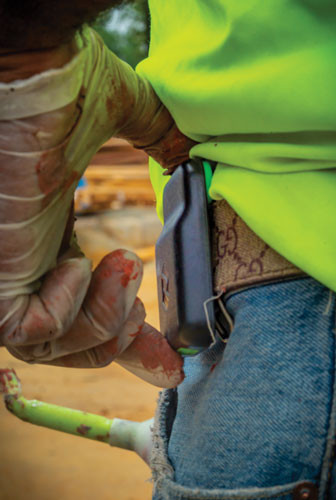
Photo provided by Triax Technologies
A wearable clip can detect falls at a job site by detecting who, where, and the distance of a fall.Dust Monitors
Originally developed for coal miners, the continuous personal dust monitor (CPDM), is used as a warning device for miners who may encounter toxic dust. Spray foam insulation has been used in mines to help fill in voids and as a repair sealant for cracks in concrete block ventilation structures. There are also a number of portable dust monitors on the market, for example GoeSonics/Vibra-Tech uses an app to help monitor dust concentration by recording wind speed and wind direction to wind rose data. The technology allows the system to measure total suspended particulate, PM10 or PM2.5. This data is then collected continuously via a remote monitoring system and posted to a customized client website with an alarm notification system.
Prevent Muscle Strain with Exoskeletons
Exoskeletons are a wearable technology which help lessen the pressure on the joints/spine. Depending on the contractor’s specific area of need, there are a number of exoskeleton choices. For example, a vest that elevates and supports workers arms, chair-less chairs to support a worker when needed while allowing movement with it strapped to their body, and a body suit which helps support a person’s weight to reduce muscle force.
The Ekso Bionics, EksoZeroG helps ease the physical burden on construction workers who use heavy hand tools, providing less fatigue, better workmanship, and fewer workplace injuries. The EksoZeroG offers up to 36.0 pounds (16.3 kg) of lift force for heavy tools. This means payloads weighing up to 36 pounds (including the tool holder, the tool, and the tool steel) will feel much lighter and can be moved with ease around the work area. ZeroG can safely support heavier loads up to 42.0 pounds (19.1 kg) but since only 36 pounds of lift is provided, heavier tools will not feel completely weightless.
Take a Break
How about a cap (hat) that can alert the wearer to any signs of fatigue? Whether a contractor is on a building site or roof, smart cap will alert the worker and foreman/sprayer in charge, if any of their staff needs a break. The supporting AFM (advanced fatigue monitoring) system data is stored on a cloud-hosting service with unlimited storage, complete with individual asset tracking making compliance auditing more manageable. Capable of capturing lines of accountability. Therefore, the smart cap lets the crew focus on safety, not paperwork. This piece of wearable technology was developed using EEG (electroencephalography/sleep science).
Fall Detection
OSHA reported fall hazards as one of the top most cited violations in 2019. Purvis Home Improvement Co, based in Saco, Maine was fined two million dollars in penalties by OSHA following the death of roofer, Alan Loignon, when he climbed down a ladder onto a scaffolding and fell 21 feet to his death.
Triax has invented the Spot-r system. This piece of unobtrusive wearable tech detects falls at a jobsite by detecting, who, where and the distance of the fall. This improves injury response time by activating the push-button alert at the bottom of a clip. The clip connects to the Spot-r network when workers arrive on site, automating time and attendance and workforce locations. Workers can also report any potential worksite hazards or signal concerns to their supervisor anywhere on the site. If there is an emergency or an evacuation need, an alarm can be triggered by authorized staff to each worker.
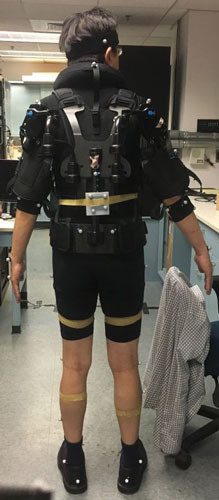
Using a motion capture system and a force plate, a NIOSH researcher wearing three various exoskeletons and reflective markers, was ready to evaluate usefulness of these exoskeletons and ability to collect valid biomechanical data during a dynamic construction task (like mast climbers).
Photo courtesy of Division of Safety Research (DSR), NIOSHSocial Distancing Alert System
Triax has just launched a social distancing and contact tracing IoT Solution, which will help keep workers safe during COVID-19 and beyond.
The Proximity Trace doesn’t use Triax’s proprietary mesh network, but rather communicates separately to a cloud dashboard specifically designed for contact tracing. The product is undergoing field testing and key feedback from early customers will be incorporated into production for commercial availability. The Proximity Trace devices are affixed to a hard hat or worn on the body with a lanyard and emits a progressively louder alarm, alerting workers when they are too close to each other. This enables them to focus on their work, rather than worrying about their proximity to another worker or potential exposure to the virus. The alarm can also serve to change behaviors by reminding workers to practice safe social distancing. In the event that there is a confirmed case of COVID-19, an employer can conduct contact tracing using historical data captured passively by the worker’s device to gauge who may have been exposed.
These are just a few examples of wearable tech on the market today with the future of wearable technology set to positively impact worker safety over the next three years. There are currently 11 percent of construction firms using wearable technology with approximately 63% predicted to have a big impact on construction safety in the next three years. “The greatest benefit of this technology is that, as a worker, you’re not alone in terms of your safety,” said John Snawder, co-director of the NIOSH Center for Direct Reading and Sensor Technologies and acting chief of the agency’s Biomonitoring and Health Assessment Branch.
Disqus website name not provided.




